Thirteen hundred miles hand-steered and no foresail, just two of the challenges we faced when completing our fifteen hundred mile trip from the Maldives to Malaysia.
With prevailing south-westerlies the first half of the trip was an incredible down-wind run, but the second half saw us sailing uphill in treacle. A fantastic journey of two halves, broken down below by each day, complete with observations, events, our turtle rescue and some great HD video clips including the one of Liz helming in a Force 6. Not to be missed!
Day One: A Slow Start – 105nm
Thanks to our delayed departure we missed the start of our weather window, a window that would have taken us right across the Indian Ocean and into the Malacca Straights with strong south-westerlies.
Still, after three months of our Maldivian shake-down we were sad to leave our temporary home. As the lights of Male disappeared over the horizon we hoped one day to return.

The winds were light and it was a gentle introduction to our long passage. Within five minutes of turning the engine off Marge our auto-pilot, gave us a break from the helm. Oh, the joy of an auto-pilot.
Day Two: Liz Makes A Boobie – 127nm
The winds had picked up to a SSW4, so we poled out the yankee to run goosewing. Talking of geese, Liz caught a first on the end of her line.
We watched as a brown boobie circled SY Esper and took a dive at her lovely sparkly lure we’d been dragging from the back of the boat. This seagull-sized bird took three attempts to dive from a great height and by the third effort he’d successfully hooked himself on the end of the line!

I dragged the poor thing through the water and up onto the boat, the hook having got stuck on its bill. The bird remained passive (as you would after drinking half a ton of the salty stuff) as I unhooked him and placed him on the solar panel to dry out. He was confused and threw up bellyfuls of sea water.
As SY Esper rolled from side to side, this poor chap had to cling onto the edge of the panels with his large, webbed feet. He must have hung out for almost an hour as he came round. He appeared to be making all the right movements but as we rolled violently to one side he slipped off the panel and disappeared!
Fortunately, as we sailed away, we could see him sitting on the water, preening his battered body, looking normal again.
We are still debating as to whether this is a brown boobie or not. If you know, please leave us a comment below.
I should add that Liz also caught a very small tuna but a little furry animal got her chops around that before it could make it into the frying pan.
Day Three: Time Is Elastic – 156nm
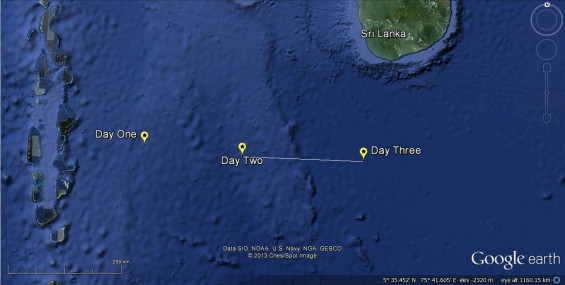 Curious things happen when you spend days at sea. Time becomes elastic. After a few days of slipping into a routine of awkward watches your body gets used to snatching minutes of sleep in between trimming the sails, reading or cooking. The great thing about this routine is that time seems to slip away very quickly.
Curious things happen when you spend days at sea. Time becomes elastic. After a few days of slipping into a routine of awkward watches your body gets used to snatching minutes of sleep in between trimming the sails, reading or cooking. The great thing about this routine is that time seems to slip away very quickly.
People often ask if it gets boring on long passages, but it never does. Each day is different. The sea state changes, cloud formations look different and the wind may shift a little. I can always identify different days at sea and sometimes they even remind me of places on land.
As you may have noticed we managed 156nm in 24 hours. That’s fast for SY Esper and we weren’t even trying. We’d reefed the main and the stupid furling problems with the head-sail meant we only had half the sail out. I wonder how many more miles we would have done had we gone all out.
Day Four: Auxiliary Rudder Disappears – 144nm
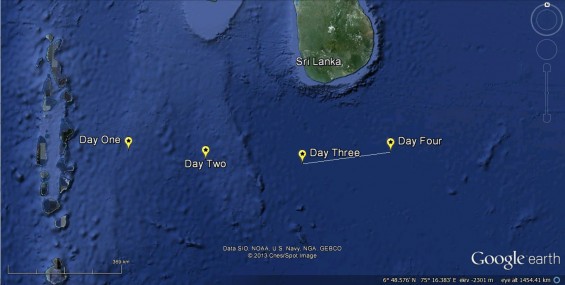 Not only do curious things happen at sea, sh!t happens too.
Not only do curious things happen at sea, sh!t happens too.
Marge had steered us from India to the Maldives, from Male to the Equator, and from there to here, decided she’d had enough.
At night, during a strong squally patch, we negotiated our way through fishermen and flashing fishing nets. It’s possible that sailing over a net may have caused our problem. After setting the sails and being happy with the course Marge was steering, I went to bed leaving Liz with strict instructions to “not touch anything”! Within minutes Liz was knocking on the hatch, complaining that SY Esper kept veering 90º to starboard.
“I can’t control the steering,” she said.
“Well, why did you touch the sails then?” I said.
“I didn’t touch anything, honest!”
I grabbed the helm and, sure enough, Esper kept steering off course. How could this be? I’ll tell you how it could be. The auxiliary rudder on the auto-pilot had simply disappeared. “I’m afraid I have some bad news” I said to Liz, after hanging off the back, torch in hand, mouth aghast at the sight of the missing rudder. “We appear to have lost our auto-pilot.” It didn’t take Liz long to recover. “Right, we’ll do two hours on, two hours off. We’ve been here before (we hand-steered over 1,000 miles on the Vasco Da Gama rally). We can do this.” Encouraged by Liz’s positive attitude I put aside any thoughts of ducking into Sri Lanka and mentally prepared myself for 1,350 miles of hand steering.
If you’ve never hand steered for an extended period before, let me tell you it hurts.
Every part of your back gets twisted and pulled as you take it in turns to first steer with your right arm, then your left. You stand up, sit down, lie down, steer backwards… anything to give your body a break from cramping up. Two hours is a long time when you steer like this, so the moment you’re relieved by the other person the only thing to do is go down below, hit the bunk and lie horizontal.
Your two hours off the helm is just enough to give your body a rest before getting back on it again.
It’s exhausting work. I’ve already blogged about hallucinations but imagine being so tired you can see people climbing onto the boat.
Help us put out more quality work,
become an FTB MATE!
It costs less than a cuppa tea…☕
Day Five: A Night of Squalls – 128nm
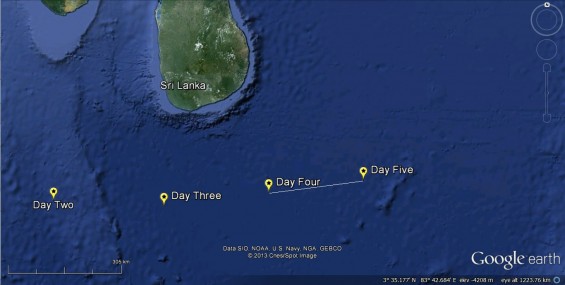 In a way, hand steering those first 24 hours prepared us for the next 24 hours of squalls.
In a way, hand steering those first 24 hours prepared us for the next 24 hours of squalls.
Unlike our trip from hell the other week, however, these squalls are running in the right direction! Even so, care must be taken not to gybe the main (the mainsail is pushed right out to catch the wind coming from behind. It’s tied into position by a ‘preventer’, but if you steer in the wrong direction the wind can get round the sail and push it across the boat. You do not want this to happen).
With gusts of over 35knots we were hammering along, often averaging 8knots and hitting 10s, 11s and 12s when the squall was at its strongest.

Liz had never run downwind for extended periods and was a little nervous. She needn’t have been though because she’s a consummate helmswoman and I never get worried when she’s behind the wheel.
Just as well since I needed my sleep.
Day Six: One Day of Headsail – 116nm
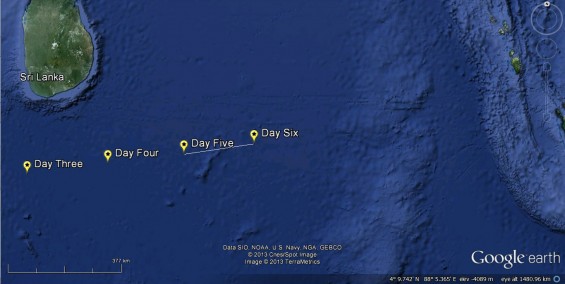 About that head-sail. We’d developed furling problems early on in our trip to the Maldives. It was getting stuck and threatened to be a big problem, which it was.
About that head-sail. We’d developed furling problems early on in our trip to the Maldives. It was getting stuck and threatened to be a big problem, which it was.
“Why didn’t you get it fixed?” people have asked.
By whom exactly? Sometimes people forget that when you’re in India or the Maldives, the closest you have to sailing expertise is over 1,000 miles away. Believe me, I’d have fixed the problem myself if I knew what the bloody problem was, and don’t think I didn’t try.
Anyway, on this day we had the luxury of the furling system allowing us to furl the sail completely out. Just as well as the wind had dropped but we had a great broad reach that day.
It was never going to last though.
Day Seven: Rolling, Rolling, Rolling – 135nm
 One of the annoyances of running down-wind is the rolling, corkscrew effect of the boat. Mostly it’s manageable but sometimes, just sometimes, like today, it becomes extremely annoying.
One of the annoyances of running down-wind is the rolling, corkscrew effect of the boat. Mostly it’s manageable but sometimes, just sometimes, like today, it becomes extremely annoying.
A day spent being hammered by squalls, all the while rolling with the waves, was mildly irritating. Still, we were making good progress, despite the white-outs (when visibility is reduced to a few metres and all you can see is a white wall of water as you get dumped on).
Having some kind of head-sail would have helped prevent some of the rolling but of course it had decided to pack up again and maintaining our speed was starting to get frustrating.
Day Eight: Turtle Rescue – 126nm
 Today goes down as a very special day, one that is indelibly stored in our memories forever. We were battling with the head-sail once more. It had got stuck furled out and more squalls were approaching. The wind had come round slightly and having the main poled out made me very uncomfortable so we decided to drop it altogether. We couldn’t furl it away so it meant releasing the halyard, dropping the sail and tying it to the guardrail. This involved a lot of shouting and swearing.
Today goes down as a very special day, one that is indelibly stored in our memories forever. We were battling with the head-sail once more. It had got stuck furled out and more squalls were approaching. The wind had come round slightly and having the main poled out made me very uncomfortable so we decided to drop it altogether. We couldn’t furl it away so it meant releasing the halyard, dropping the sail and tying it to the guardrail. This involved a lot of shouting and swearing.
Liz and I normally work well as a team but the hand steering and erratic behaviour of Esper as she rolled down those waves were taking their toll. I hadn’t slept and Liz was growing tired at the helm. In the end we were shouting at each other just for the sake of shouting, a therapeutic exercise to rid our bodies of the aches.
I was too tired to even tie the sail down so I left that job to Liz and I took the helm, bringing the boat into wind and dousing her with spray, much to her annoyance. The seas had started to build and when we turned the boat into wind we realised we were bobbing around in 5m swells.
On the horizon was the ubiquitous storm cloud, heading roughly in our directly. As Liz completed the sail-tying task I spotted a fishing net float past with a number of fish circling it. As it drifted past us I thought I saw a sunfish, its fin flopping around on the water’s surface, but when I took a closer look I noticed it was a turtle. “How cute”, I thought, until I realised this poor animal was trapped in the net. Liz wrote about what happened next in her entry for The Guardian travel writing competition, she was runner-up:
I clung to the guard rail and looped a rope round the broken foresail. A wave rose, then fell back before it reached me. We were adrift in an Indian Ocean the colour of dishwater. A platoon of grey clouds marched across the sky, softening us up before the storm.
Just a couple more knots to secure the flapping sail and I would be safe, back in the cockpit with Jamie. Then the engine roared, and the boat drove forward into wind. The next wave crashed over me.
“What the fuck are you doing?” I shouted.
Jamie, behind the wheel, pointed at a ridge of water. “There’s a turtle in distress,” he said.
I scanned the sea’s hills and valleys, and saw a bunch of netting and floats. “It’s nothing, just junk,” I said.
Then a flipper reached out of the water and sank back into the jetsam. I felt hollow. Land was 600 miles away, and we had been on two-hour watches for days; I didn’t want to think about distressed turtles. I shrugged.
“Well? What do you want to do about it?”
I gave no encouragement, no sign that I cared.
“I won’t forgive myself if we leave without trying to help,” he said.
Jamie, my strong skipper, looked lost. Aware of obligations beyond my understanding, I softened. In the cockpit we had a quick hug; I took the wheel and Jamie unclipped the boat hook. We turned our yacht round, allowing the turtle to gently float alongside. Jamie snagged the net.
“It’s two turtles!” he said, “but I can’t hold them.”
He lunged over the side and thrust bare hands through the mesh. The nylon line which trapped and was strangling the animals, now cut into his fingers. Spidery crabs clambered everywhere, sharpening their claws in anticipation of the feast to follow. Fins circled in the shadows beneath.
To have any chance of freeing the turtles, we would have to haul them on board. I tried to hook a rope through the tangle, but the clip jumped from my grip and the line swung away from the boat. Jamie stood to catch it while I held the unbreakable web with gloved hands. But he missed and the rope flew away again, out over the waves.
Cursing the fishermen for dumping their net, I tugged at the heavy load and pulled it clear of the water. Crabs crawled up my arms. Jamie, his hands now bleeding, scrambled next to me and together we heaved the whole stinking mess into the cockpit.
The first rain pellets began to pepper the deck. We worked in silence. Cutting the turtles free was quick with our sharp sailing knives. Their shells were smooth, glossy and serrated towards the back, and creamy underneath. They peered into our eyes. Afterwards we wondered what they had been thinking.
As the clouds darkened, we slipped them back into the water. Then the gale hit.
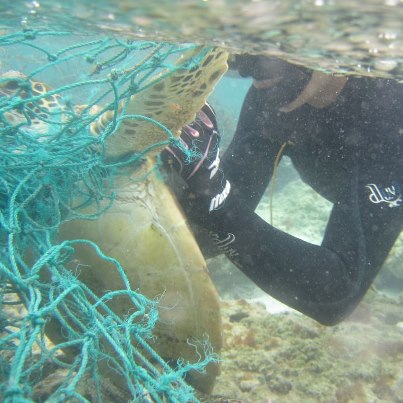
Since telling this story to people almost everyone’s response has been “where are the photos”, but it just didn’t happen like that. Tired, with oncoming squalls, in 5m swells, the priority was to cut these little blighters free of the net and get them back in the water as quickly as possible. A photograph would only have provided some personal glory but we didn’t care.
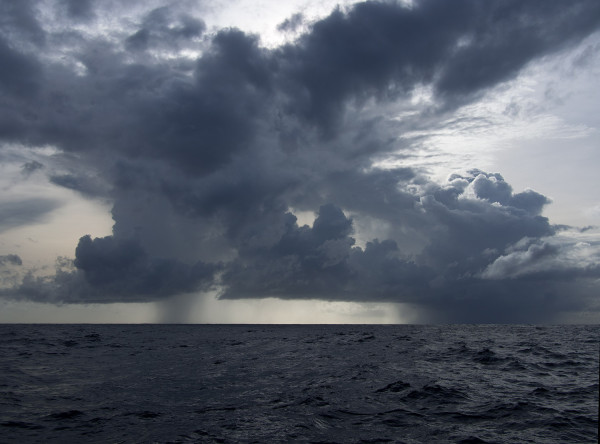
“Right, let’s get the hell out of here” I said. We turned around with the wind behind us, and made our exit. I can’t begin to describe the elation we felt afterwards. We were both exhausted from all the hand steering, and just a little pissed off at having lost the head-sail, but our rescue had revitalised us, giving us some positive energy to deal with the rest of the squalls we had to contend with that day.
Day Nine: Broken Main – 122nm
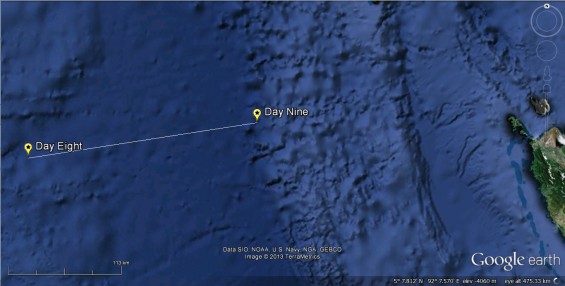 Today I successfully broke the outhaul car on the mainsail. This is a block on ball-bearings that runs on a track across the boom and is supposed to assist in bringing out the main. It’s a pile of 25 year old shit, so when I glanced up to watch the ball-bearings plop into the sea, and the clew of the sail ping upwards, I wasn’t particularly upset. It’s happened once before and cost a not too cheap $300 replacement, but lashing the sail down instead works just as well so that’s what I did. I was too tired to let it bother me.
Today I successfully broke the outhaul car on the mainsail. This is a block on ball-bearings that runs on a track across the boom and is supposed to assist in bringing out the main. It’s a pile of 25 year old shit, so when I glanced up to watch the ball-bearings plop into the sea, and the clew of the sail ping upwards, I wasn’t particularly upset. It’s happened once before and cost a not too cheap $300 replacement, but lashing the sail down instead works just as well so that’s what I did. I was too tired to let it bother me. 
Day Ten: Motoring Uphill – 90nm
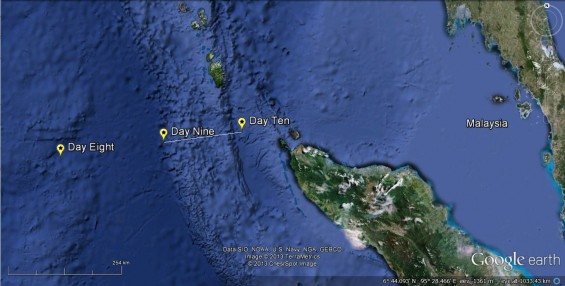 After nine days of great downwind sailing, our fun was over. From here on in the winds would slow and we would lose the current that had been contributing to our fast sail. If you remember I’d said earlier that sometimes different days reminded me of different places on land. Today I felt like I was going for a very slow amble through a wintry Essex countryside, trudging through a dirty field on a slight incline, grey clouds seemingly hampering my progress. That was today’s sail. I could almost swear on my life that we were sailing uphill. Seriously, it felt like there was an incline in the sea and we were at the bottom of it.
After nine days of great downwind sailing, our fun was over. From here on in the winds would slow and we would lose the current that had been contributing to our fast sail. If you remember I’d said earlier that sometimes different days reminded me of different places on land. Today I felt like I was going for a very slow amble through a wintry Essex countryside, trudging through a dirty field on a slight incline, grey clouds seemingly hampering my progress. That was today’s sail. I could almost swear on my life that we were sailing uphill. Seriously, it felt like there was an incline in the sea and we were at the bottom of it.
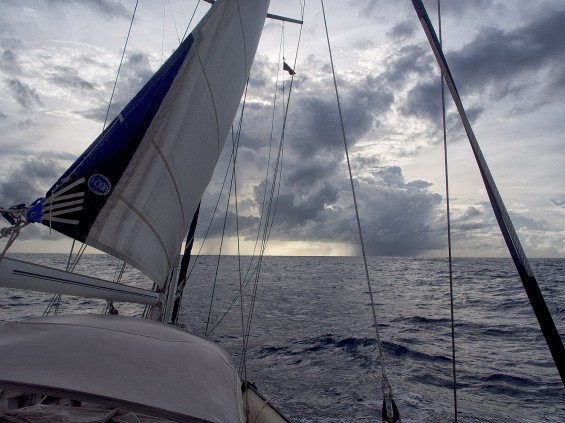
My log entry for today reads “Boring, difficult, backwards”.
Day Eleven: Land Ahoy! – 68nm

And if I thought yesterday was bad enough, just take a look at the amount of miles we covered over the last 24 hours! We’d effectively halved our speed and with no wind we were simply motoring against a bastard current. I hate days like this. To make matters worse, on the horizon was the most immense lightning display I have ever seen, hanging over a mountain that was our first land sighting for eleven days. Lightning was flashing horizontally across the sky, with balls of bright flashes blinding us and creating evil-looking forks down onto the sea. When a yachtsman sees this kind of weather there is only one thought that goes through his head: I am the tallest thing on water, how long before that lightning hits me? 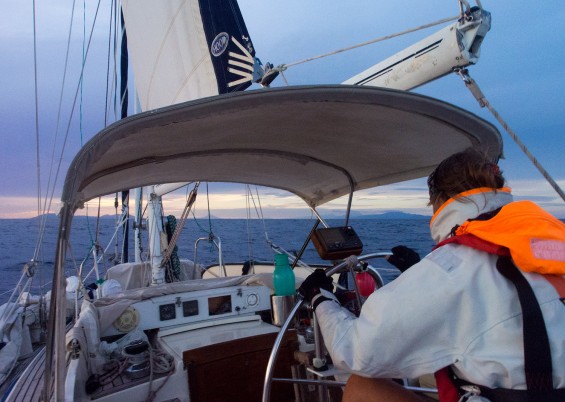 We were coming round the coast of Sumatra and towards the island of Pulau Weh. I have since found out that it’s notorious for its storms, but should we need to, we could drop into the lee of the island and find a safe anchorage. Throughout the course of the night the storm subsided, and when Liz woke me in the early morning there was an incredible sunrise made more spectacular by the mountains. Still, 68nm in 24 hours? That’s just rubbish.
We were coming round the coast of Sumatra and towards the island of Pulau Weh. I have since found out that it’s notorious for its storms, but should we need to, we could drop into the lee of the island and find a safe anchorage. Throughout the course of the night the storm subsided, and when Liz woke me in the early morning there was an incredible sunrise made more spectacular by the mountains. Still, 68nm in 24 hours? That’s just rubbish.
Day Twelve: Ship Roulette – 123nm
 Throughout the journey we’d been communicating via sat-phone with SY Chinook and SY Divanty. We’d been giving each other progress reports, position updates and any weather info that might prove useful. Chinook had left a week before us so were that much further ahead, though they had to duck in to Pulau Weh in order to make some sail repairs. I remember asking Brian what it was like entering the Malacca Straits. “Ship roulette” was his reply. He wasn’t wrong. Even with AIS navigating our way through the fishing boats was interesting, shall we say? Divanty had said “there are plenty of fishing vessels but they all appear to be displaying the correct lighting configurations.” Really? Not from where I was helming! We had vessels showing five green lights, flashing red beacons, arc-lights shining upwards, downwards, sideways… it was a veritable collection of Christmas decorations that night. The thing is, these fishermen are so engrossed in their fishing they’re not aware that you’re approaching, so the trick is to steer well clear of them. Difficult when they keep moving across your path, but then we’ve sailed the Indian coast, and if you can successfully navigate your way through 1,200 miles of Indian fishermen, this becomes a cinch.
Throughout the journey we’d been communicating via sat-phone with SY Chinook and SY Divanty. We’d been giving each other progress reports, position updates and any weather info that might prove useful. Chinook had left a week before us so were that much further ahead, though they had to duck in to Pulau Weh in order to make some sail repairs. I remember asking Brian what it was like entering the Malacca Straits. “Ship roulette” was his reply. He wasn’t wrong. Even with AIS navigating our way through the fishing boats was interesting, shall we say? Divanty had said “there are plenty of fishing vessels but they all appear to be displaying the correct lighting configurations.” Really? Not from where I was helming! We had vessels showing five green lights, flashing red beacons, arc-lights shining upwards, downwards, sideways… it was a veritable collection of Christmas decorations that night. The thing is, these fishermen are so engrossed in their fishing they’re not aware that you’re approaching, so the trick is to steer well clear of them. Difficult when they keep moving across your path, but then we’ve sailed the Indian coast, and if you can successfully navigate your way through 1,200 miles of Indian fishermen, this becomes a cinch.
Day Thirteen: Storm Dodging – 135nm

For the last few days we’d been motor-sailing. We’d picked up some current and some unexpected WNW put in an appearance too. We were on the home stretch but the squalls continued, as did those fishing boats. By now we were just desperate to get to our destination and, as the next squall approached from behind, so the island of Langkawi disappeared behind another squall ahead of us. Well, it is monsoon season, what do you expect?
We were greeted with another white-out as we approached the channel and then made our way up towards Royal Langkawi Yacht Club in drizzle. By this point we were in VHF communication with Ants, who was giving us tips and advice on this new and strange land. It reminded me vaguely of Turkey, with the volcanic, mountainous backdrops and boats at anchor in every little cove. The difference is that the waters are shallow here so we dog-legged it round the last bend to avoid a shallow spot and eventually motored our way into the marina.

There on the first pontoon was Ants, VHF in hand, directing us towards our berth. Despite the rain, standing on the edge of our new home was Davina of Divanty, Fiona of Roam II and Deb of Chinook. No sooner had the lines been tied did Fiona hand us two very cold beers, accompanied by a big hug. What a wonderful welcome!
Peace and fair winds!
Liz, Jamie and Millie xxx
🎬 SUBSCRIBE TO THE FTB SAILING CHANNEL!
🛒 FTB SHOP – GRAB SOME MERCH!
🤝 BECOME AN FTB MATE!
If none of the above floats your boat, please consider supporting us by clicking an icon below and sharing this post. Cheers!
If you like our content and would like to support us, we will give you ad-free access to our videos before they go live to the public, discounts in our shop, access to Jamie’s iconic full-res photographs, and supporter-only blog posts. Click our ugly mugs for more info!






Wow! Just wow. Cahones grandes.
Cheers, guys! It’s still imprinted on my mind. A passage never to forget… Liz x
Great read! found this blog via google as we plan the same trip next year July. good to see that it can be done during monsoon season. for now we will continue our sailing practice the Maldives for another 11 months before setting sail.
Glad to see you made it relatively incident free
As a resolute dry-bob I find reading your commentary at the same time inspiring and terrifying. I hope Malaysia is all you expect it to be.
Really enjoyed reading about the experiences of your voyage, especially as I know you and Esper are now tucked up safely in the marina of Langkawi RYC.
Wishing you a happy time exploring the beautiful surroundings of the Island.